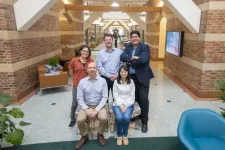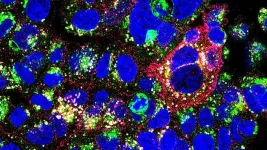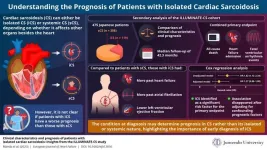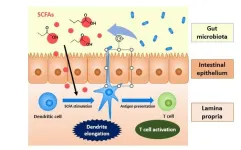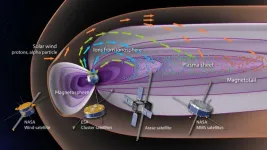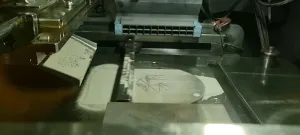(Press-News.org) Good things come in microscopic packages, according to the Beckman Institute for Advanced Science and Technology’s new DROPLETS project.
By packaging electrochemical reactions in smaller-than-standard serving sizes, interdisciplinary researchers aim to produce clean hydrogen, sequester carbon dioxide, and store renewable energies like wind and solar inexpensively and sustainably. Their project, called DROPLETS, received $4.5 million from the U.S. Department of Energy’s Office of Science through its Energy Earthshots Initiative.
“If we do this right, we will lay out a foundation for our clean energy future,” said project lead Joaquín Rodríguez-López, a professor of chemistry at the University of Illinois Urbana-Champaign and a researcher at the Beckman Institute for Advanced Science and Technology. “And the foundation for that clean energy future is electrochemistry.”
Captivated by the synergy between chemistry and electricity, Rodríguez-López has already used electrochemistry to capture carbon dioxide in the atmosphere, recycle plastics, and design batteries to store renewable energy.
Now, he's siccing his electrified science on the Energy Earthshots Initiative, a U.S. Department of Energy program created to quash net carbon emissions by 2050 and make renewable energy usable and accessible for more Americans in the next decade. The initiative supports projects that address specific clean energy challenge areas called Earthshots.
In late September, the DOE announced its dispersal of $264 million across 29 projects: 18 university-based teams like Rodríguez-López’s received a total of $69.1 million through the Funding Opportunity Announcement for Science Foundations for Energy Earthshots, and 11 Energy Earthshot Research Centers led by national labs received a collective $195 million.
“The Energy Earthshot Research Centers and the related work happening on college campuses around the country will be instrumental in developing the clean energy and decarbonization solutions we need to establish a 100% clean grid and beat climate change,” said U.S. Secretary of Energy Jennifer M. Granholm in a DOE press release.
Rodríguez-López’s proposal, which secured $4.5 million, intersects three Earthshots focused on broadening the clean hydrogen market (Hydrogen Shot); enabling low-cost, long-term energy storage (Long-Duration Storage Shot); and supporting efforts to capture carbon dioxide by the gigaton, a unit equivalent to 182 million American homes’ annual electricity use (Carbon Negative Shot).
The latter is particularly thorny because of its invisibility, according to Rodríguez-López — our eyes don’t register carbon dioxide accumulation as readily as smoggy clouds circling a cityscape or smokestacks billowing from an old-growth forest.
“But it’s there,” he said. “And it’s a problem.”
Rodríguez-López’s proposed solution is similarly invisible to the naked eye.
The project reimagines the electrochemical reactions used to advance clean energy (for example, splitting water to generate hydrogen). Typically, such reactions simmer away in a single beaker and are beholden to an electrochemical reactor and its cornucopia of awkward hardware.
“You have cables, electrodes, the reactor itself — the entire system can take up physical space and can be financially limiting as well. There are many situations where an electrochemical reactor can be limiting. I want to push past those limits to take electrochemistry outside of the reactor,” Rodríguez-López said.
For Rodríguez-López, thinking outside the reactor means decentralizing the reaction.
His riff on the classic single-beaker setup involves running multiple reactions simultaneously in microscopic, water-based droplets — like scattered bistro furniture as an artful alternative to a single dining table.
“Microdroplets are exactly what you’d imagine,” he said, “Very, very small droplets of solution that you need a microscope to see.”
While squinting is required to see them in action, microdroplets make up for their diminutive stature with lightness of foot. Like swapping a seven-layer cake for a sheet of cupcakes in the oven, microdroplet-based reactions have been observed to cook (or catalyze) faster than they would in bulk.
But unlike baked goods, a microdroplet's chemical composition is not an exact mimic of its larger counterpart. Therein lies its (literal) power: the researchers hypothesize that the droplets’ microscopic size will distinctly alter the physical and chemical properties of the electrochemical reactions taking place inside.
Each property — portability, affordability, speed, electrification — equips microdroplets to host chemical reactions that can help generate clean hydrogen, store energy, and trap carbon dioxide — an electrified arrow through all three of the project's target Energy Earthshots.
Achieving multiple Energy Earthshots was important to the research team, which consists of a dozen researchers across three UIUC departments and five total institutions.
“It’s not only the number of minds, but the expertise that they bring,” Rodríguez-López said. “Clean energy research does not exist in a vacuum, and I wanted the interdisciplinary component to be there in the DNA of the group from the very start — because interdisciplinary approaches lead to diverse applications.”
Indeed, practical applications of DROPLETS are varied. Clean hydrogen, for example, may be used to create fuel cells, which power cars and buses (and, according to the DOE, heavy-duty trucks) while producing nothing but heat and water. Electricity-based flow batteries might help to inexpensively store wind and solar energy beyond the bounds of a single windstorm or sunny Saturday. Carbon capture techniques will not only extract the pollutant from the atmosphere, but “put it to good use” by folding it into carbon-based compounds, Rodríguez-López said.
“It is a risky project, but the payoff will be great,” he said. “We have very smart researchers, and very smart students, and very smart postdocs, and that means we have a shot — an Earthshot.”
A homespun derivative of the term moonshot, the DOE’s flagship phrase encapsulates the spirit of DROPLETS: exploratory, imaginative, rounded in research and anchored in not-too-distant applications.
“Exploring new reactions, creating new pathways,” Rodríguez-López said. “What better project for a chemist?”
~
Editor's note:
Read the full announcement from the DOE Office of Science: https://content.govdelivery.com/accounts/USDOEOS/bulletins/3734192
Additional investigators affiliated with the Beckman Institute include Qian Chen, the Racheff Faculty Scholar and an associate professor of materials science and engineering; Jeffrey Moore, the Stanley O. Ikenberry Endowed Chair Emeritus of Chemistry and a professor emeritus of chemistry; and Charles Schroeder, the Dr. Ray and Beverly Mentzer Professor and a professor of chemical and biomolecular engineering and the James Economy Professor of materials science and engineering.
Additional UIUC investigators include Paul Kenis, a professor of chemical and biomolecular engineering; Christy Landes, the Jerry A. Walker Endowed Chair and a professor of chemistry; Lisa Olshansky, an assistant professor of chemistry; and Hong Yang, the Richard C. Alkire Chair and professor of chemical and biomolecular engineering.
Researchers from the Georgia Institute of Technology, Northern Arizona University, Texas State University, and Argonne National Laboratory also contributed to this project.
END
Microdroplets, macro results: Beckman researchers pursue Energy Earthshots
Good things come in microscopic packages, according to the Beckman Institute for Advanced Science and Technology’s new DROPLETS project.
2023-10-30
ELSE PRESS RELEASES FROM THIS DATE:
Landmark menopause toolkit updated to improve assessment and treatment
2023-10-30
Care for women with menopausal health issues should improve globally following the release of an updated Monash University-led toolkit that guides health professionals around the world in assessing and treating them.
Endorsed by the International, Australasian and British Menopause Societies, the Endocrine Society of Australia and Jean Hailes for Women’s Health, the 2023 Practitioner’s Toolkit for Managing the Menopause is designed to be used anywhere in the world.
Published in Climacteric, the Toolkit has been updated and enhanced from the original 2014 Toolkit for practitioners with new advice and therapies based on a systematic review of the latest menopause ...
New antibody could target breast cancers
2023-10-30
An enzyme that may help some breast cancers spread can be stopped with an antibody created in the lab of Cold Spring Harbor Laboratory Professor Nicholas Tonks. With further development, the antibody might offer an effective drug treatment for those same breast cancers.
The new antibody targets an enzyme called PTPRD that is overabundant in some breast cancers. PTPRD belongs to a family of molecules known as protein tyrosine phosphatases (PTPs), which help regulate many cellular processes. They do this by working in concert with enzymes called kinases to control how other proteins ...
Drawing a tube of blood could assess ALS risk from environmental toxin exposure
2023-10-30
Over the last decade, research at Michigan Medicine has shown how exposure to toxins in the environment, such as pesticides and carcinogenic PCBs, affect the risk of developing and dying from amyotrophic lateral sclerosis.
Now, investigators have developed an environmental risk score that assesses a person’s risk for developing ALS, as well as for survival after diagnosis, using a blood sample.
The results are published in the Journal of Neurology, Neurosurgery and Psychiatry.
“For the first time, we have a means collecting ...
Research grants available: $50,000 to evaluate race in risk calculators
2023-10-30
DALLAS, October 30, 2023 — Multiple 1-year grants of up to $50,000 each are available from the American Heart Association to fund research that evaluates the use of race in heart disease and stroke risk calculators.
The American Heart Association, the single largest non-government supporter of heart and brain health research in the U.S., is offering the funding as part of the De-Biasing Clinical Care Algorithms project. The project is a two-year scientific research strategy, supported in part by a grant from the Doris Duke Foundation, to study the complex issue of how race and ethnicity factor into clinical care ...
Shedding light on the paradoxical prognosis for patients with cardiac sarcoidosis, a rare and difficult-to-diagnose inflammatory heart condition
2023-10-30
Sarcoidosis is a complex inflammatory disease that causes the harmful accumulation of tiny clumps of cells called granulomas in the body. In most cases, sarcoidosis manifests in the lungs and lymph nodes. However, in approximately 10% of patients, the heart is affected; this condition is known as ‘cardiac sarcoidosis (CS).’ Although relatively rare, CS can cause life-threatening complications, including arrhythmia, heart failure, or sudden cardiac death.
One puzzling aspect of CS is that the condition sometimes involves the heart alone, without manifesting clinically apparent symptoms in other organs. This is referred to as isolated ...
Intestinal bacteria metabolite promotes capture of antigens by dendritic cells
2023-10-30
Dendritic cells play a key role in the mammalian immune system. These cells are present throughout the human body and are known to capture foreign bodies, i.e., antigens, using extendable “arms” called dendrites. Once captured, dendritic cells present these substances to immune T cells, thereby initiating an immune response. Dendritic cells are responsive to their environment and capable of changing their morphology and other attributes dynamically. For instance, dendritic cells in the intestine’s mucosa (inner layer) capture harmful bacteria by extending their dendrites through the epithelium (outermost layer) ...
Virtual meetings tire people because we're doing them wrong
2023-10-30
New research suggests sleepiness during virtual meetings is caused by mental underload and boredom. Earlier studies suggested that fatigue from virtual meetings stems from mental overload, but new research from Aalto University shows that sleepiness during virtual meetings might actually be a result of mental underload and boredom.
‘I expected to find that people get stressed in remote meetings. But the result was the opposite – especially those who were not engaged in their work quickly became ...
The importance of the Earth’s atmosphere in creating the large storms that affect satellite communications
2023-10-30
A study from an international team led by researchers from Nagoya University in Japan and the University of New Hampshire in the United States has revealed the importance of the Earth’s upper atmosphere in determining how large geomagnetic storms develop. Their findings reveal the previously underestimated importance of the Earth’s atmosphere. Understanding the factors that cause geomagnetic storms is important because they can have a direct impact on the Earth’s magnetic field such ...
Using lasers to ‘heat and beat’ 3D-printed steel could help reduce costs
2023-10-30
Researchers have developed a new method for 3D printing metal that could help reduce costs and make more efficient use of resources.
The method, developed by a research team led by the University of Cambridge, allows structural modifications to be ‘programmed’ into metal alloys during 3D printing, fine-tuning their properties without the ‘heating and beating’ process that’s been in use for thousands of years.
The new 3D printing method combines the best qualities of both worlds: the complex shapes that 3D printing makes possible, and the ability to engineer ...
Positive messages can mitigate harm from objectified fitness posts
2023-10-30
PULLMAN, Wash. – A few words of body appreciation can help counter the negative impact of viewing objectified images of female fitness influencers, according to a Washington State University study.
While fitness influencers say they want to inspire good physical health, research has found that their social media posts often inspire negative mental health, especially among younger women. The WSU experimental study, published in the journal Health Communication, revealed that the negative impact ...
LAST 30 PRESS RELEASES:
Eye for trouble: Automated counting for chromosome issues under the microscope
The vast majority of US rivers lack any protections from human activities, new research finds
Ultrasound-responsive in situ antigen "nanocatchers" open a new paradigm for personalized tumor immunotherapy
Environmental “superbugs” in our rivers and soils: new one health review warns of growing antimicrobial resistance crisis
Triple threat in greenhouse farming: how heavy metals, microplastics, and antibiotic resistance genes unite to challenge sustainable food production
Earthworms turn manure into a powerful tool against antibiotic resistance
AI turns water into an early warning network for hidden biological pollutants
Hidden hotspots on “green” plastics: biodegradable and conventional plastics shape very different antibiotic resistance risks in river microbiomes
Engineered biochar enzyme system clears toxic phenolic acids and restores pepper seed germination in continuous cropping soils
Retail therapy fail? Online shopping linked to stress, says study
How well-meaning allies can increase stress for marginalized people
Commercially viable biomanufacturing: designer yeast turns sugar into lucrative chemical 3-HP
Control valve discovered in gut’s plumbing system
George Mason University leads phase 2 clinical trial for pill to help maintain weight loss after GLP-1s
Hop to it: research from Shedd Aquarium tracks conch movement to set new conservation guidance
Weight loss drugs and bariatric surgery improve the body’s fat ‘balance:’ study
The Age of Fishes began with mass death
TB harnesses part of immune defense system to cause infection
Important new source of oxidation in the atmosphere found
A tug-of-war explains a decades-old question about how bacteria swim
Strengthened immune defense against cancer
Engineering the development of the pancreas
The Journal of Nuclear Medicine ahead-of-print tip sheet: Jan. 9, 2026
Mount Sinai researchers help create largest immune cell atlas of bone marrow in multiple myeloma patients
Why it is so hard to get started on an unpleasant task: Scientists identify a “motivation brake”
Body composition changes after bariatric surgery or treatment with GLP-1 receptor agonists
Targeted regulation of abortion providers laws and pregnancies conceived through fertility treatment
Press registration is now open for the 2026 ACMG Annual Clinical Genetics Meeting
Understanding sex-based differences and the role of bone morphogenetic protein signaling in Alzheimer’s disease
Breakthrough in thin-film electrolytes pushes solid oxide fuel cells forward
[Press-News.org] Microdroplets, macro results: Beckman researchers pursue Energy EarthshotsGood things come in microscopic packages, according to the Beckman Institute for Advanced Science and Technology’s new DROPLETS project.
